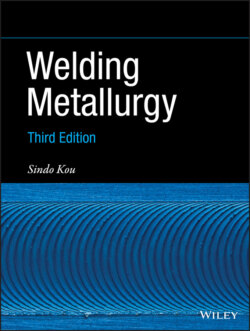Читать книгу Welding Metallurgy - Sindo Kou - Страница 51
1.5 Resistance Spot Welding
ОглавлениеThe resistance spot welding (RSW) process is shown schematically in Figure 1.33. Two overlapping metal parts are squeezed tightly against each other by the tips of two opposing electrodes that are water‐cooled. The resistance to the electric current passing through the electrodes and parts can exist in the form of bulk resistance and contact resistance. The highest resistance usually is at the faying surfaces (represented by Point 4), thus causing local heating and melting at the faying surfaces to form a weld nugget after cooling.
Figure 1.33 Resistance spot welding: (a) overview; (b) resistance to electric current; (c) weld nugget.
The electrode clamping force need to be sufficient to keep the liquid in the nugget from being expelled, called expulsion or spitting. The lower density of liquid than solid causes volume expansion upon melting and promotes expulsion. Expulsion can leave insufficient liquid in the nugget to form a continuous solid weld, resulting in large voids and weakening the weld.
The key process variables include the welding current (usually several thousands to tens of thousands of amperes), welding time, clamping force, and electrode shape. The copper electrodes are often alloyed with refractory metals to improve erosion resistance. It is desirable to have a nugget with a diameter about 3.5–4 times the sheet thickness and a height about two‐thirds the combined thickness of the sheets [27]. To reduce erosion, some electrode tips are coated with special materials.
In welding dissimilar metals, e.g., Cu to steel as shown in Figure 1.34, heat balance may need to be considered. The much higher thermal conductivity of Cu than steel may prevents Cu from being melted sufficiently. So, Cu can be thicker and a smaller electrode tip area can be used to increase the current density. Alternatively, an electrode tip with high electrical resistance material such as tungsten or molybdenum can be used.
Figure 1.34 Resistance spot welding of dissimilar metals with highly different thermal conductivities.
